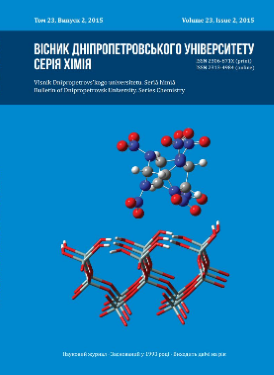The peculiarities of electrooxidation of Mn<sup>2+</sup> to MnO<sub>2</sub> in acetate electrolyte
DOI:
https://doi.org/10.15421/081515Keywords:
Mn2 acetate complexes, electrooxidation, quantum-chemical modelingAbstract
The results of investigation of Mn2+ electrooxidation mechanism in the presence of acetate ions have been presented. The kinetic measurements were supplemented by quantum-chemical modeling. The calculated value of the redox potential of [Mn(H2O)5Ac]+/[Mn(H2O)5Ac]2+ system was compared with experimental data obtained at pH 5.2. The similar values have given a reason to assume the direct electrooxidation of ion Mn2+ to Mn3+ like complex [Mn(H2O)5Ac]+. The process occurs according to inner-sphere mechanism due to direct contact of the complex with the electrode through the carboxyl group. The quantum-chemical calculations have shown the impossibility of elimination of second electron without considerable reorganization of the complex [Mn(H2O)5Ac]2+. The final product of electrooxidation of Mn2+ acetate complex, manganese dioxide, was formed as a result of [Mn(H2O)5Ac]2+ disproportionation with subsequent hydrolysis of the [Mn(H2O)5Ac]3+ complex. In weakly acidic solution (pH above 4) due to reducing the number of [Mn(H2O)5Ac]+ complexes, electrooxidation of manganese ions were occurred by a similar mechanism to the acid sulphate solution, i. e. by radicals, produced by electrooxidation of water molecules.References
Brenet, J. P. (1979). Electrochemical behavior of metallic oxides. J. Pover Sources, 4, 183–190.
Adelchani, H., & Ghaemi M. (2009). Influence of the solution pH on the nanostructural and electrochemical performance of electrolytic manganese dioxide. J. Alloys Compd., 481, 446–449.
Clarke, C. J., Browning, G. J., & Donne, S. W. (2006). An RDE and RRDE study into the electrodeposition of manganese dioxide. Electrochim. Acta., 51, 5773–5784.
Qu, D. Y., Bai, L., Castledine, C. G., Conway, B. E., & Adams, W. A. (1994). Spectro-electrochemical studies on production and role of soluble Mn(III) species in discharge and recharge of various MnO2 cathode materials. J. Electroanal. Chem., 365, 247–259.
Vargalyuk, V. F., & Poltavets, V. V. (2015). [Electro-oxidation of Mn2 + ions at a platinum electrode]. Suchasni problemi elektrohimii: osvita, science, virobnitstvo – Modern problems of electrochemistry: education, science and industry, 143–144 (in Ukrainian).
Patrushev, V. V., Kononov, Y. S., & Stop, S. W. (2002). Russian Patent No. RU 2193527 C1. Institute of Chemistry and Chemical Technology.
Serdyuk, V. A., & Vargalyuk, V. F. (2008). [Evaluation of reliability of quantum chemical calculations of the electronic transitions in aqua complexes of transition metals]. Russ. J. Electrochem, 44(10), 20–27 (in Russian).
Ravdel, A. A., & Ponomareva, A. M. (Ed.). (1983). [A quick reference physico-chemical variables]. Leningrad, USSR: Chemistry (in Russian).
Rossoti, F., & Rossoti, H. (1965). [Determination of stability constants and other equilibrium constants in solutions]. Moskow, USSR: Mir (in Russian).
Downloads
Published
Issue
Section
License
Copyright (c) 2015 Oles Honchar Dnipropetrovsk National University

This work is licensed under a Creative Commons Attribution 4.0 International License.
- Authors reserve the right of attribution for the submitted manuscript, while transferring to the Journal the right to publish the article under the Creative Commons Attribution License. This license allows free distribution of the published work under the condition of proper attribution of the original authors and the initial publication source (i.e. the Journal)
- Authors have the right to enter into separate agreements for additional non-exclusive distribution of the work in the form it was published in the Journal (such as publishing the article on the institutional website or as a part of a monograph), provided the original publication in this Journal is properly referenced
- The Journal allows and encourages online publication of the manuscripts (such as on personal web pages), even when such a manuscript is still under editorial consideration, since it allows for a productive scientific discussion and better citation dynamics (see The Effect of Open Access).


